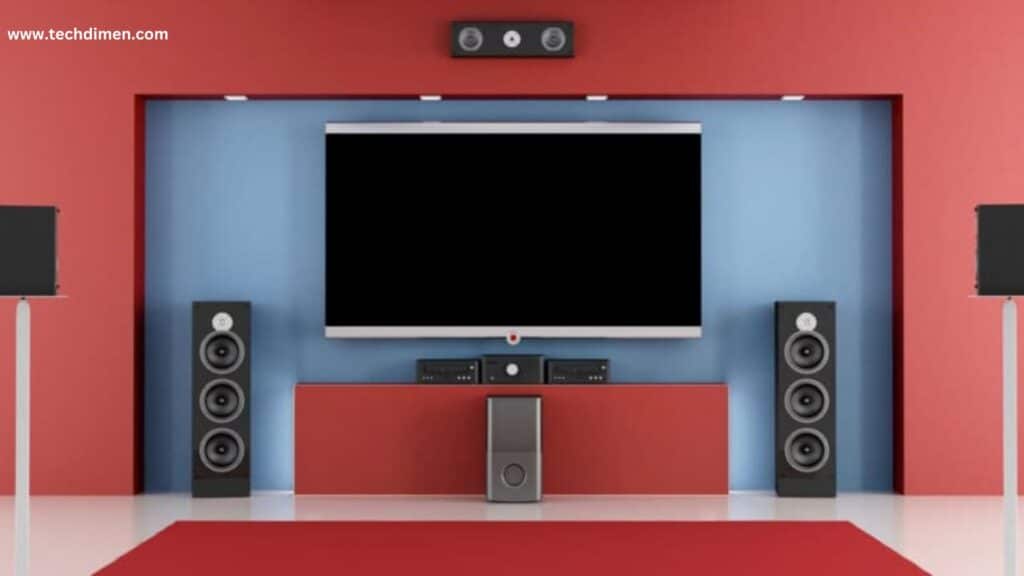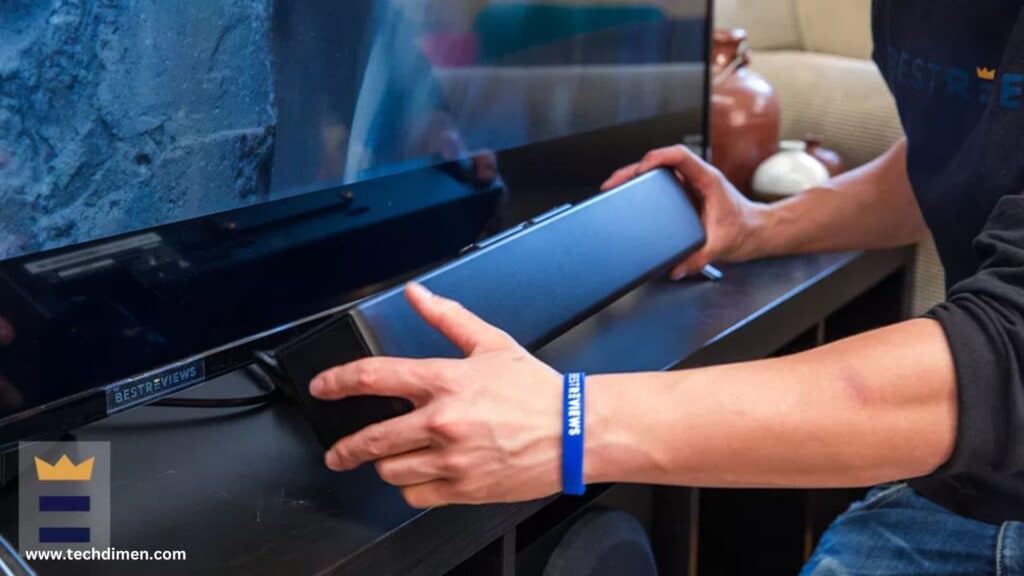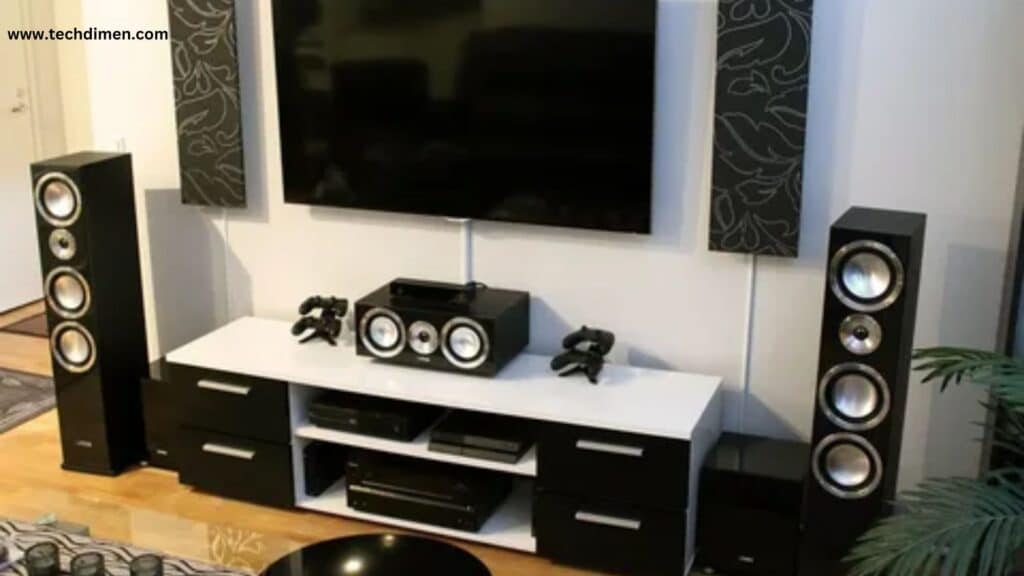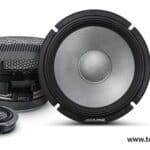TV Sound Systems ever sat through a movie and had to crank up the volume to hear the dialogue, only to get blasted by the next explosion scene, you’re not alone. Built in TV speakers often fall short. They’re small, face the wrong direction, and simply don’t offer the rich, immersive sound most viewers want. That’s where a dedicated TV Sound Systemsmakes all the difference. In this in depth guide, we’ll explore what modern sound systems for TVs actually offer in 2025. From innovations like AI Sound Pro and Clear Voice Pro, to cutting-edge formats like Dolby Atmos and the rise of wireless surround sound via WISA audio systems, you’ll get a clear understanding of what matters and why.
Why Upgrading Your TV Audio Is Worth It
TV technology has evolved rapidly, delivering ultra thin screens, stunning 4K and 8K visuals, and advanced smart features. But audio hasn’t kept up in many cases. Today’s paper thin displays simply don’t have the room to house proper speakers. As a result, you get a picture that looks great but sound that’s often flat and unbalanced. Improving your TV audio quality brings noticeable benefits. You get clearer dialogue, more powerful bass, and directional sound that brings games, movies, and even talk shows to life. Watching TV becomes more immersive, more emotional, and just more enjoyable overall.
What Makes Up a TV Sound System

The core of most TV sound systems today starts with a soundbar, which sits under your screen and provides a dramatic upgrade over your TV’s built in speakers. Many modern soundbars are smart, slim, and capable of creating virtual surround sound environments. Several now include Dolby Atmos soundbar support, delivering height based audio for more realism. Subwoofers have also become more important.
These dedicated bass modules often connect wirelessly and are designed to fill in the low end frequencies that soundbars can’t always hit. If you want to hear the rumble of an earthquake or the beat of a bass-heavy soundtrack, a subwoofer is essential. Rear speakers are another piece of the puzzle. These can either be wired or wireless and are critical if you want true surround sound. Unlike simulated systems, real surround setups help you hear footsteps behind you or cars passing from left to right with proper spatial placement.
Lastly, advanced receivers are optional now with modern all in one solutions, but if you go for a component system, they act as the central hub for all your speakers and sources.
The Power of Voice Enhancement Technologies

Dialogue clarity has become one of the most important aspects of audio for most viewers. Whether it’s a drama where actors whisper or an action movie where sound effects drown out conversations, muffled speech is frustrating. Clear Voice Pro, available on LG TVs and soundbars, solves this problem by isolating human voices from background sounds. It boosts the vocal range while lowering ambient noise. This makes it easier to hear characters speak without raising the volume too high. Viewers with hearing issues or those watching at night will appreciate this subtle but powerful improvement. Another useful technology is audio normalization. Unlike volume leveling, which just evens out the peaks, normalization intelligently adjusts the loudness of different scenes. So you won’t be constantly reaching for the remote every time a commercial break comes on or a movie jumps between quiet dialogue and booming action.
Both of these features work well with modern content and are often enhanced when using connections like HDMI eARC, which supports high bandwidth, uncompressed audio.
AI Driven Sound Is Here

Modern audio systems now include artificial intelligence. These systems don’t just play sound they analyze it and adapt in this time. One of the best examples is AI Sound Pro, found on LG’s newer models. It listens to what’s playing and adjusts the sound profile based on the type of content. If you’re watching a live concert, it will emphasize vocals and instruments. If you switch to a sci fi movie, it’ll add more depth to effects and ambient sounds.
Samsung has its own system called Adaptive Sound. It does something similar but also considers your room acoustics. Built in microphones detect your space and the ambient noise, then calibrate the audio output accordingly. This system helps separate voices from explosions or music, enhancing clarity while preserving immersion. This kind of AI audio enhancement is more than just a gimmick. It allows sound systems to act dynamically rather than using static settings. In other words, your system becomes smarter over time and adapts to what you’re watching without you needing to adjust settings manually.
Object Tracking Sound and Dolby Atmos

Samsung’s Object Tracking Sound or OTS is one of the most exciting audio technologies in recent years. You may have heard about it and wondered, “What does Object Tracking Sound do on Samsung TVs?” It essentially creates a 3D audio space by projecting sound from different parts of the TV itself. So when a car drives across the screen, it sounds like it’s actually moving from left to right in your room.
This immersive effect is created through multiple strategically placed speakers on the TV frame. Combined with motion sensors and AI, OTS delivers positional sound that feels almost like being in a movie theater. To get the most out of it, Samsung recommends a TV size of 65 inches or larger, though lighter versions like OTS Lite exist for smaller models. Paired with Dolby Atmos, which adds vertical sound (think helicopters above or rainfall from the ceiling), you get a near cinematic experience. These formats use object based audio instead of simple channels, placing sound in 3D space rather than just left, right, or center. DTS:X, a competitor to Dolby Atmos, also supports similar 3D spatial audio, and both are found on most premium TVs and sound systems in 2025.
Making the Most of Your Soundbar Setup

Even if you’ve invested in a top tier soundbar for TV, poor setup can ruin the experience. Sound is highly dependent on room layout, speaker placement, and TV settings. For small rooms, virtual surround systems with upward firing speakers can simulate a wide soundstage. In medium rooms, adding wireless rear speakers gives a much fuller sound. For larger rooms, a hybrid of wired and wireless components especially with WISA audio system compatibility can deliver consistent performance across the space. To ensure optimal quality, avoid placing speakers in tight corners or behind objects.
Subwoofers work best when placed near the front wall, and rear speakers should be at ear level for proper directional audio. Don’t forget to explore your TV’s smart audio settings, like enabling Dolby Digital Plus or PCM depending on the source. And if your sound system supports HDMI eARC, use it. It allows uncompressed, high bandwidth audio that Bluetooth or optical cables simply can’t match.
Going Wireless with WISA

If you’re looking for truly wireless surround sound, WISA certified systems are the most advanced option today. WISA, short for Wireless Speaker and Audio Association, provides high-resolution, low latency audio over secure frequencies.
Unlike Bluetooth, which compresses audio and suffers from delays, WISA transmits uncompressed 24 bit audio at 96 kHz with latency under 5 milliseconds. That means voices sync perfectly with lips, and sound effects stay in perfect timing with visuals.
One major advantage of WISA is that it doesn’t require a receiver. Instead, most systems use a small USB transmitter that plugs into your TV or console. As long as the devices are WISA compatible, setup is nearly instant. However, WISA does come at a higher price point and has fewer plug and play options, so it’s best for users who prioritize quality and are willing to invest.
Compared to standard wireless speaker systems, WISA offers better fidelity, less interference, and more consistent performance, even in busy wireless environments like apartments.
Designing the Right System for Your Space

When building or upgrading your home theater system, the first step is evaluating your room. Small spaces work best with 3.1 or 5.1 setups. You can get great performance with a soundbar and subwoofer, especially if the system includes Dolby Atmos virtualization.
Medium rooms benefit from 5.1.2 or 7.1 configurations. This adds either ceiling speakers or upward firing drivers for vertical sound layers. Larger spaces call for 7.1.4 setups or full WISA based systems with multiple drivers placed around the room.
In terms of cost, users can expect to spend under $500 for basic setups, between $600 and $1,200 for mid tier systems with Dolby Atmos, and upward of $1,500 for premium systems with WISA support and true surround performance.
Smart speaker layout, room calibration tools, and up to date firmware can take even modest setups to the next level.
Expert Picks for the TV Sound Systems

The best soundbar for dialogue clarity this year is LG’s S80TR, thanks to Clear Voice Pro. For all around performance, Samsung’s HW Q990D offers 11.1.4 channels with Dolby Atmos and wireless rear speakers. If you’re aiming for a wireless home theater, Platin Audio’s Monaco 5.1 WISA system is the top choice, delivering high res audio without a single cable between speakers. Budget conscious buyers will find great value in the Vizio M Series 5.1, which still includes a subwoofer and rear speakers for under $500.
TV Sound System Feature Overview
| Feature | Brand | What It Does | Benefit |
|---|---|---|---|
| Clear Voice Pro | LG | Boosts dialogue, lowers background noise | Clearer speech in movies/shows |
| AI Sound Pro | LG | Adapts sound to scenes using AI | Better immersion and detail |
| Adaptive Sound | Samsung | Adjusts sound based on room/content | Consistent, optimized audio |
| Object Tracking Sound | Samsung | Makes sound follow on-screen motion | 3D, lifelike experience |
| WISA | LG, Klipsch | Wireless speaker system | No cables, easy surround sound |
| HDMI eARC | All Brands | Sends high-quality sound via HDMI | Supports Atmos & DTS:X |
| Dolby Atmos / DTS:X | Most Brands | 3D surround sound formats | Cinema-like audio at home |
| Auto Volume Leveling | LG, Samsung | Keeps volume steady | No sudden loud or quiet parts |
FAQs: TV Sound Systems
What’s the best sound system setup for modern TVs?
It depends on your needs. A Dolby Atmos soundbar is great for easy setup and immersive sound. For full home theater vibes, go with a 5.1 or 7.1 speaker system from trusted brands like Bowers & Wilkins, Wharfedale, or Sony.
Is a soundbar better than built in TV speakers?
Yes. Soundbars provide clearer dialogue, stronger bass, and better surround effects. TV speakers are limited by size and often sound flat, especially in larger rooms.
What does LG’s AI Sound Pro do?
AI Sound Pro analyzes the scene in real time whether it’s dialogue, action, or music and automatically adjusts the sound to match. It helps make voices clearer and sound effects more realistic.
What is Clear Voice Pro?
Clear Voice Pro boosts spoken dialogue by lowering background noise and evening out volume. This is especially helpful in scenes with whispering or soft speech.
What is Samsung Adaptive Sound?
Adaptive Sound uses AI and built in mics to adjust sound based on your room and content. It ensures voices are clear and loud moments don’t overpower quiet scenes.
How does Samsung Object Tracking Sound (OTS) work?
Object Tracking Sound (OTS) creates directional sound that follows the movement on screen. If a car moves left to right, the sound moves with it, giving you a more lifelike experience.
What is WISA audio?
WISA is a wireless audio tech that lets you connect up to eight speakers without a receiver. It offers high resolution sound and a clean setup with no messy wires.
Do I still need an AV receiver for surround TV Sound Systems?
Not always. Wireless setups like WISA or smart Dolby Atmos soundbars can replace receivers. But for advanced custom systems, a receiver still offers the most flexibility.
Why is HDMI eARC important?
HDMI eARC allows for high quality audio formats like Dolby Atmos to travel between your TV and sound system with no compression. It’s crucial for modern home audio setups.
Can I get real surround TV Sound Systems without wires?
Yes. Systems like Sonos, Samsung wireless rears, or WISA enabled speakers deliver high quality surround sound without the need for cables running across your room.
Final Thoughts: TV Sound Systems
Audio makes up half the experience when watching movies or playing games. A great TV sound system takes your entertainment to another level making voices sharper, explosions more powerful, and soundscapes more immersive. Whether you’re choosing a Dolby Atmos soundbar, using AI Sound Pro, or going all in with a WISA audio system, 2025 offers more ways than ever to get theater-quality sound at home.
If you’re ready to finally stop rewinding scenes just to hear what was said or if you want to feel every roar, shot, or soundtrack then it’s time to upgrade. The right setup is out there, and it’s more accessible, intelligent, and wireless than ever before.

Jhon AJS is a tech enthusiast and author at Tech Dimen, where he explores the latest trends in technology and TV dimensions. With a passion for simplifying complex topics, Jhon aims to make tech accessible and engaging for readers of all levels.







